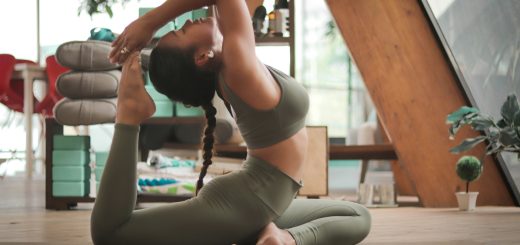Restorative Yoga: Nourish & Renew Your Spirit

Before diving in, please note: This post is for informational purposes only. If you’d like to know more about how we approach topics, feel free to check out our friendly Disclaimer Page.
Hey there, amazing readers! 🖐️ Just a quick note: yes, we know there are a lot of ads here. Trust us, we get it—it’s not the prettiest look, but they help us keep this blog alive and kicking. Those pesky little ads cover the costs of all the behind-the-scenes magic, from hosting and tech stuff to creating content we hope you’ll love.
We’re committed to delivering quality posts, and your support (even just sticking around despite the ads) means everything to us. So, bear with us, and thanks for helping us keep the good vibes rolling. Now, on to the fun stuff! 😉
TRANSLATE BUTTON AT THE END OF THE ARTICLE
A Quick Overview
Restorative yoga is a gentle and therapeutic form of yoga that focuses on relaxation and rejuvenation.
Unlike more active styles of yoga, restorative yoga involves holding passive poses for an extended period of time, usually between 5 to 20 minutes.
The emphasis is on deep breathing, mindfulness, and allowing the body to relax and release tension.
Restorative yoga is suitable for practitioners of all levels, including beginners, and can be particularly beneficial for those looking to reduce stress, improve flexibility, and promote overall well-being.
What is Restorative Yoga?
Restorative yoga is a practice that aims to create a state of deep relaxation in the body and mind.
It involves using props such as blankets, bolsters, and blocks to support the body in gentle, passive poses.
By holding these poses for an extended period of time, the body is able to release tension and stress, leading to a sense of calm and renewal.
Restorative yoga is often referred to as the "yoga of non-doing," as it encourages practitioners to let go of the need to perform or achieve, and instead focus on surrendering to the present moment.
Benefits of Restorative Yoga
The benefits of restorative yoga are numerous and far-reaching.
Some of the key benefits include:
Stress reduction: Restorative yoga activates the parasympathetic nervous system, which helps to counteract the effects of stress and promote relaxation.
Improved flexibility: Holding gentle poses for an extended period of time allows the muscles to release tension and lengthen, resulting in increased flexibility.
Enhanced mindfulness: Restorative yoga encourages practitioners to be present in the moment, fostering a sense of mindfulness and awareness.
Better sleep: The relaxation and deep breathing techniques used in restorative yoga can help improve sleep quality and promote a sense of calm before bedtime.
Balanced mood: Restorative yoga has been shown to help regulate mood and reduce symptoms of anxiety and depression.
How Restorative Yoga Nourishes Your Spirit
Restorative yoga nourishes the spirit by providing a space for relaxation, introspection, and self-care.
By allowing the body and mind to rest deeply, practitioners can connect with their inner selves and cultivate a sense of inner peace and harmony.
This practice helps to replenish and renew the spirit, providing a much-needed break from the busyness and stress of daily life.
Restorative yoga encourages practitioners to listen to their bodies, honor their limits, and practice self-compassion, all of which are essential for nourishing the spirit.
Principles of Restorative Yoga Practice
There are several key principles that guide the practice of restorative yoga:
Surrender: Restorative yoga is about letting go of the need to achieve or perform and surrendering to the present moment.
Support: Props such as blankets, bolsters, and blocks are used to support the body in poses, allowing for deep relaxation and release.
Breath: Deep, mindful breathing is essential in restorative yoga, helping to calm the nervous system and promote relaxation.
Stillness: Poses are held for an extended period of time, allowing the body to settle and the mind to quiet.
Awareness: Practitioners are encouraged to be present and aware of their bodies, breath, and thoughts throughout the practice.
Poses for Restorative Yoga
Some common restorative yoga poses include:
Supported Child’s Pose: This pose is gentle on the back and hips and promotes relaxation and release.
Supported Savasana: Also known as Corpse Pose, this pose involves lying on the back with props supporting the body for deep relaxation.
Supported Bridge Pose: This pose helps to open the chest and shoulders, while also providing a gentle stretch for the spine.
Legs-Up-the-Wall Pose: This pose is excellent for relieving tension in the legs and lower back, while also promoting circulation and relaxation.
Breathing Techniques in Restorative Yoga
Breathwork is an essential component of restorative yoga practice.
Some common breathing techniques used in restorative yoga include:
Diaphragmatic breathing: This technique involves breathing deeply into the belly, allowing for full expansion of the lungs and promoting relaxation.
4-7-8 breathing: Inhale for a count of 4, hold for 7, and exhale for 8.
This breathing pattern can help calm the nervous system and reduce stress.
Alternate nostril breathing: This technique involves breathing in and out through one nostril at a time, helping to balance the body’s energy and promote relaxation.
Tools for Restorative Yoga Practice
In addition to props such as blankets, bolsters, and blocks, there are a few tools that can enhance your restorative yoga practice:
Eye pillow: A weighted eye pillow can help to promote relaxation and release tension in the eyes and forehead.
Essential oils: Aromatherapy can enhance the restorative experience, with scents like lavender and chamomile promoting relaxation and calm.
Soft music or nature sounds: Playing gentle, soothing music or nature sounds can create a serene atmosphere for your practice.
Creating a Restorative Yoga Space
Creating a dedicated space for your restorative yoga practice can help enhance the experience.
Some tips for creating a restorative yoga space include:
Choose a quiet, calming location: Find a space in your home that is free from distractions and promotes a sense of peace and tranquility.
Use soft lighting: Soft, diffused lighting can help create a relaxing atmosphere for your practice.
Add natural elements: Bring in plants, crystals, or other natural elements to create a grounding and soothing environment.
Incorporating Meditation into Restorative Yoga
Meditation and restorative yoga complement each other beautifully, as both practices promote mindfulness, relaxation, and self-awareness.
You can incorporate meditation into your restorative yoga practice by:
Beginning or ending your practice with a short meditation: Take a few minutes to sit quietly, focus on your breath, and cultivate a sense of inner stillness.
Using guided meditation: Listen to a guided meditation recording while in a restorative yoga pose to deepen relaxation and promote mindfulness.
Mindful breathing: Bring awareness to your breath during your restorative yoga practice, using it as a focal point for meditation.
Restorative Yoga for Stress Relief
Restorative yoga is an excellent practice for stress relief, as it helps to activate the body’s relaxation response and calm the nervous system.
By releasing tension in the body and promoting deep relaxation, restorative yoga can help reduce feelings of anxiety and overwhelm.
Regular practice of restorative yoga can provide a valuable tool for managing stress and promoting a sense of calm and balance in daily life.
Restorative Yoga for Healing
Restorative yoga can be a powerful tool for healing both the body and mind.
By allowing the body to rest deeply and release tension, restorative yoga can help facilitate healing on a physical, emotional, and spiritual level.
This practice is particularly beneficial for those recovering from injury or illness, as it provides a gentle and nurturing way to support the body’s natural healing processes.
Restorative yoga can also help to release emotional blockages and promote self-healing and inner growth.
Restorative Yoga for Self-Care and Renewal
Self-care is essential for overall well-being, and restorative yoga offers a gentle and nurturing way to care for yourself.
By taking the time to rest and relax deeply, you can replenish your energy, reduce stress, and promote a sense of inner peace and renewal.
Restorative yoga encourages practitioners to prioritize self-care and listen to their bodies, fostering a sense of self-compassion and self-love.
Making restorative yoga a regular part of your self-care routine can help you feel more balanced, grounded, and rejuvenated.
Conclusion
Restorative yoga is a deeply nourishing and renewing practice that can benefit practitioners of all levels.
By promoting relaxation, stress relief, and self-care, restorative yoga offers a valuable tool for fostering a sense of inner peace and well-being.
Whether you are looking to reduce stress, improve flexibility, or promote healing, incorporating restorative yoga into your routine can help you nourish and renew your spirit.
By embracing the principles of surrender, support, breath, stillness, and awareness, you can experience the transformative benefits of restorative yoga in your life.

The Enlightenment Journey is a remarkable collection of writings authored by a distinguished group of experts in the fields of spirituality, new age, and esoteric knowledge.
This anthology features a diverse assembly of well-experienced authors who bring their profound insights and credible perspectives to the forefront.
Each contributor possesses a wealth of knowledge and wisdom, making them authorities in their respective domains.
Together, they offer readers a transformative journey into the realms of spiritual growth, self-discovery, and esoteric enlightenment.
The Enlightenment Journey is a testament to the collective expertise of these luminaries, providing readers with a rich tapestry of ideas and information to illuminate their spiritual path.
Our Diverse Expertise 🌟
While our primary focus is on spirituality and esotericism, we are equally passionate about exploring a wide range of other topics and niches 🌍📚. Our experienced team is dedicated to delivering high-quality, informative content across various subjects ✨.
To ensure we provide the most accurate and valuable insights, we collaborate with trusted experts in their respective domains 🧑🏫👩🏫. This allows us to offer well-rounded perspectives and knowledge to our readers.
Our blog originally focused on spirituality and metaphysics, but we’ve since expanded to cover a wide range of niches. Don’t worry—we continue to publish a lot of articles on spirituality! Frequently visit our blog to explore our diverse content and stay tuned for more insightful reads.






